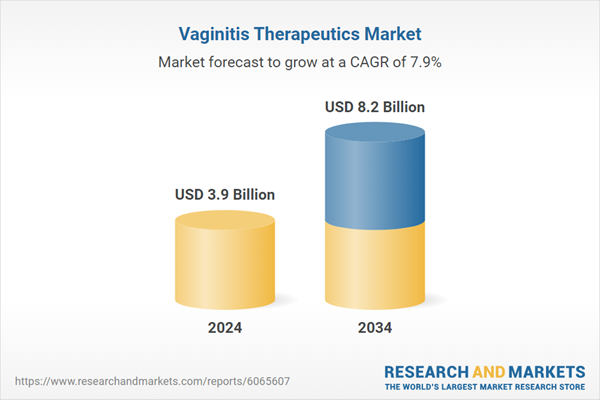Shifting sexual behaviors and greater stress levels are also contributing to the vulnerability of women to such conditions. In recent years, heightened public awareness and broader access to information on reproductive health have encouraged women to pursue early treatment. This awareness is further supported by educational initiatives and national campaigns that emphasize the importance of intimate health care.
Medical advancements are also playing a pivotal role in improving the detection and treatment of vaginal infections. Innovative diagnostic tools now allow for quicker and more accurate identification of pathogens, enabling targeted therapies and improved patient outcomes. Moreover, many regulatory authorities are fast-tracking treatments that address gaps in women’s health, opening opportunities for companies to introduce new formulations. With vaginitis care increasingly being incorporated into health coverage plans in several regions, more women have access to professional medical support and medications.
Alongside this, investments in sexual and reproductive health by global health agencies are strengthening the overall healthcare infrastructure to manage conditions like vaginitis. As feminine wellness gains traction as a mainstream health category, growing consumer interest in personal care and wellness-focused brands continue to contribute to market growth.
Vaginitis therapeutics include treatments formulated to manage and relieve inflammation and discomfort in the vaginal area due to infections or irritants. These treatments vary depending on the root cause of the infection - be it fungal, bacterial, or parasitic - and are available in oral, topical, or intravaginal forms. The therapeutic landscape continues to evolve with a focus on faster relief, fewer recurrences, and enhanced overall reproductive health.
By disease type, the market is segmented into bacterial vaginosis, candidiasis, trichomoniasis, and others. Bacterial vaginosis emerged as the leading segment in 2024, generating revenue of USD 1.6 billion. Its high prevalence among reproductive-aged women and its tendency to recur has created sustained demand for reliable treatment options. The condition is often linked with further complications, reinforcing the need for effective and timely intervention.
When analyzed by treatment type, the anti-fungal segment held the highest market share of 42.7% in 2024. However, the anti-bacterial segment also maintained a strong foothold due to its critical role in managing bacterial vaginosis. Antibiotics like metronidazole and clindamycin, available in both oral and topical forms, are frequently prescribed for their effectiveness in reducing symptoms. Recurrent infections often necessitate continued or repeated use of these medications, driving consistent demand. Innovations such as extended-release formulations and combination drugs are also improving patient adherence and outcomes.
In terms of route of administration, topical treatments led the market with a revenue of USD 2.5 billion in 2024. These therapies offer targeted relief with minimal systemic effects, making them a popular choice among women. Products like creams, gels, and suppositories provide localized treatment for conditions such as candidiasis and trichomoniasis. Many individuals prefer topical options for their convenience and reduced risk of side effects. The accessibility of over-the-counter topical products further supports their widespread use, particularly for those seeking discreet and quick solutions.
The market is also segmented by mode into over-the-counter (OTC) and prescription drugs. The OTC segment is expected to grow at the fastest pace, registering a CAGR of 8.4% during the forecast period. This growth is attributed to the increasing tendency among women to self-medicate, especially for mild to moderate symptoms. OTC options such as tablets, creams, and suppositories are easily available across retail and online pharmacies, which adds to their popularity. Cost efficiency and privacy are additional factors pushing more consumers toward non-prescription alternatives.
Distribution channels for vaginitis therapeutics include hospital pharmacies, retail outlets, and online platforms. Hospital pharmacies are projected to reach USD 3.5 billion by 2034, owing to their essential role in managing moderate to severe cases under medical supervision. These settings ensure the precise dispensing of medications and allow for close patient monitoring, especially in complex or recurrent infections. Hospital-based treatment also benefits from structured insurance reimbursement policies, particularly in regions with well-established healthcare systems.
Geographically, North America led the global market with a 38.1% share in 2024. The region’s dominance can be attributed to strong healthcare infrastructure, advanced diagnostic capabilities, and high awareness of women’s health. In the United States alone, the market grew from USD 1.26 billion in 2023 to USD 1.34 billion in 2024, reflecting a consistent upward trajectory supported by increased insurance coverage and access to OB/GYN services.
The competitive landscape remains moderately consolidated, with major companies accounting for 60-70% of the total market share. Industry leaders are pursuing a variety of strategies, including mergers, acquisitions, product innovation, and expansion into related therapeutic areas. Many are also investing in research and development to introduce improved formulations and diversify their offerings in adjacent markets like urinary health and menopause care.
Comprehensive Market Analysis and Forecast
- Industry trends, key growth drivers, challenges, future opportunities, and regulatory landscape
- Competitive landscape with Porter’s Five Forces and PESTEL analysis
- Market size, segmentation, and regional forecasts
- In-depth company profiles, business strategies, financial insights, and SWOT analysis
This product will be delivered within 2-4 business days.
Table of Contents
COMPANIES MENTIONED
The companies featured in this vaginitis therapeutics market report include:- AdvaCare Pharma
- Bayer
- Cipla
- Combe
- Lupin Pharmaceuticals
- Mycovia Pharmaceuticals
- Organon
- Pfizer
- Prestige Consumer Healthcare
- Sanofi
- SCYNEXIS
- Sun Pharmaceuticals
Table Information
| Report Attribute | Details |
|---|---|
| No. of Pages | 135 |
| Published | June 2025 |
| Forecast Period | 2024 - 2034 |
| Estimated Market Value ( USD | $ 3.9 Billion |
| Forecasted Market Value ( USD | $ 8.2 Billion |
| Compound Annual Growth Rate | 7.9% |
| Regions Covered | Global |
| No. of Companies Mentioned | 13 |









